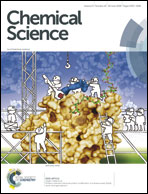Sustainable p-type copper selenide solar material with ultra-large absorption coefficient†
Abstract
Earth-abundant solar absorber materials with large optical absorption coefficients in the visible enable the fabrication of low-cost high-efficiency single and multi-junction thin-film solar cells. Here, we report a new p-type semiconductor, Cu4TiSe4 (CTSe), featuring indirect (1.15 eV) and direct (1.34 eV) band gaps in the optimal range for solar absorber materials. CTSe crystallizes in a new noncentrosymmetric cubic structure (space group F![[4 with combining macron]](https://www.rsc.org/images/entities/char_0034_0304.gif) 3c) in which CuSe4 tetrahedra share edges and corners to form octahedral anionic clusters, [Cu4Se4]4−, which in turn share corners to build the three-dimensional framework, with Ti4+ ions located at tetrahedral interstices within the channels. The unique crystal structure and the Ti 3d orbital character of the conduction band of CTSe give rise to near-optimal band gap values and ultra-large absorption coefficients (larger than 105 cm−1) throughout the visible range, which are promising for scalable low-cost high-efficiency CTSe-based thin-film solar cells.
3c) in which CuSe4 tetrahedra share edges and corners to form octahedral anionic clusters, [Cu4Se4]4−, which in turn share corners to build the three-dimensional framework, with Ti4+ ions located at tetrahedral interstices within the channels. The unique crystal structure and the Ti 3d orbital character of the conduction band of CTSe give rise to near-optimal band gap values and ultra-large absorption coefficients (larger than 105 cm−1) throughout the visible range, which are promising for scalable low-cost high-efficiency CTSe-based thin-film solar cells.



 Please wait while we load your content...
Please wait while we load your content...